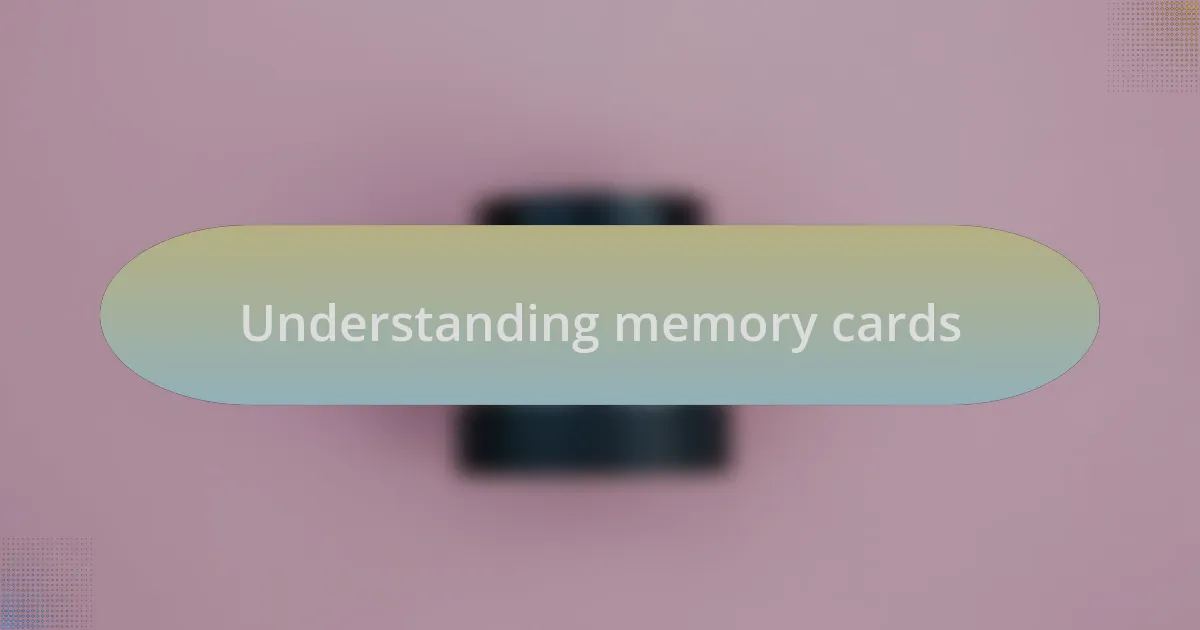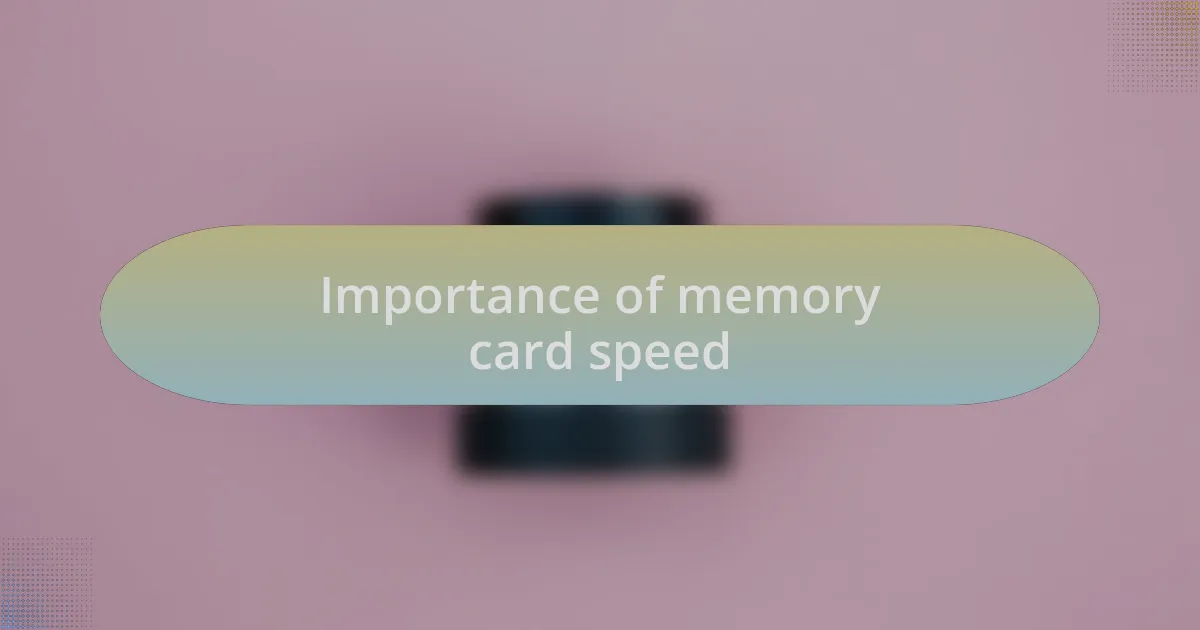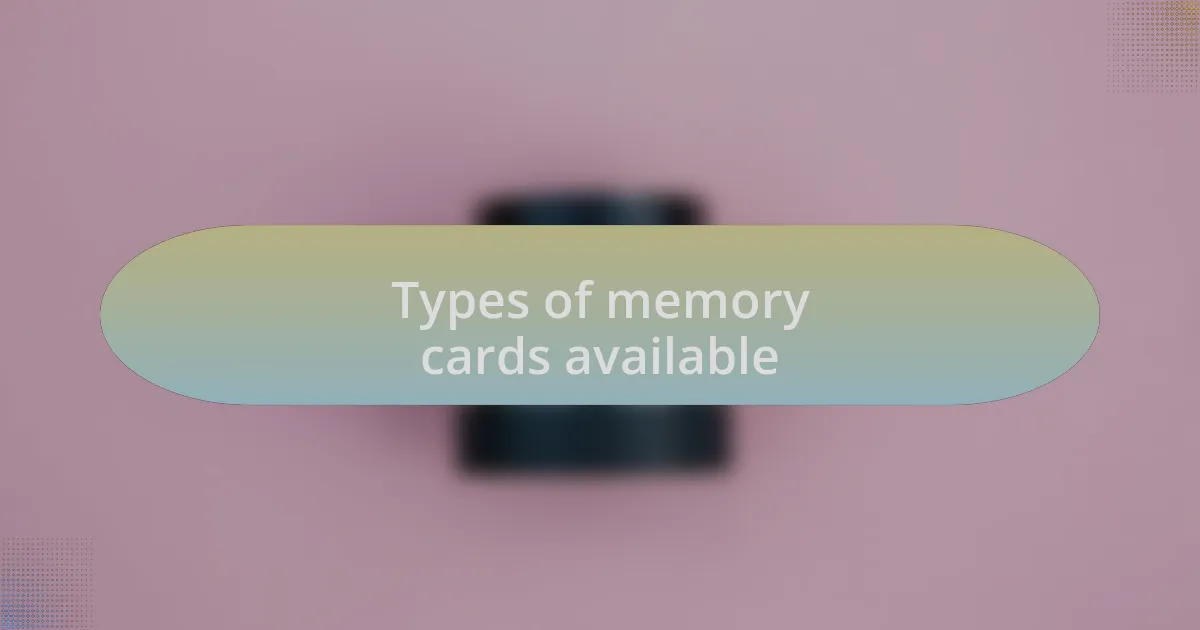Key takeaways:
- Memory card speed and capacity are crucial for capturing high-quality images and videos, particularly during fast-paced events.
- Different memory card types (SD, microSD, CF, XQD, CFast) cater to specific photography needs and can significantly enhance the shooting experience.
- Evaluating memory card capacity based on file format and anticipated shooting style is essential to avoid running out of storage at critical moments.
- Brands like SanDisk, Lexar, and Sony are recommended for their reliability and performance, especially in challenging conditions.

Understanding memory cards
Memory cards are essential for anyone serious about photography. They store images and videos, enabling us to capture our memories without a second thought. I remember the excitement and anxiety I felt during a family vacation when I realized I had packed an insufficient memory card. It left me questioning: how could I ensure I’m always prepared for those spontaneous moments?
When choosing a memory card, it’s vital to consider its speed and capacity. A high-speed card can significantly impact your ability to shoot in quick succession—especially important during events like weddings or sports. I’ve experienced the frustration of missing the perfect shot due to a lagging card, which drives home the point that investing in the right memory card can save you from heartache later on.
Additionally, understanding different memory card types—like SD, microSD, and CF—can be a game-changer. Each type has its own strengths and weaknesses, and the right one often depends on your camera and shooting style. Think about your own experiences: have you ever adapted your equipment to a particular shoot? Realizing the nuances of memory cards can elevate your photography experience, allowing you to focus more on creativity rather than technical limitations.

Importance of memory card speed
When it comes to memory cards, speed is a critical factor that I’ve learned shouldn’t be overlooked. I once missed capturing a breathtaking sunset because my card was slow, which caused a delay between shots. Have you ever felt that frustrating pause when you’re ready to click? Having a high-speed card means you can shoot continuously without worrying about dropped frames or buffering.
Imagine being in the middle of a fast-paced event. With a slower card, you could find yourself fumbling with your camera instead of enjoying the moment. The last wedding I attended was an eye-opener; my friend’s quick reflexes went to waste due to her outdated memory card. It was a key reminder that a card’s write speed—and its ability to handle the data generated by high-resolution images and burst shooting—are vital to ensure that I never miss those fleeting moments again.
Not only does card speed affect performance, but it can also enhance the overall workflow. After upgrading to a faster card, I noticed a significant reduction in upload times when transferring files to my computer. Isn’t it satisfying to feel less stressed about managing your photo library? Investing in a high-speed memory card isn’t just about avoiding hiccups in the moment; it’s about making the entire photography experience more seamless and enjoyable.

Types of memory cards available
When it comes to memory cards, you’ll find a variety of formats tailored for different needs. The most common types are SD cards, which are widely used in cameras and smartphones, and CF cards, often found in professional DSLRs. I remember my first experience with a CF card; it felt like stepping into the world of advanced photography, but my understanding of their nuances took time to develop.
Then you have microSD cards, prized for their compact size—perfect for action cameras and drones. I’ll never forget how handy my microSD card was during a hiking trip; it allowed me to capture stunning landscapes without lugging around bulky equipment. Can you relate to that moment when you’re traveling light but still want to make every shot count?
Lastly, we should consider specialized formats like XQD and CFast cards, which offer high-speed transfers for professional videography. Investing in one for a recent project truly transformed my workflow, reducing the time I spent waiting for files to transfer. Have you ever wished you could cut that wait time down? I know I have, and now, with the right gear, I can focus more on being creative and less on the technical hurdles.

Evaluating memory card capacity
When I evaluate memory card capacity, I like to think about the type of photography or videography I’m planning to do. For instance, shooting in RAW format requires significantly more space than JPEG, which can often lead to the “Oh no, I’m out of space!” panic during a critical moment. Remember that time you were capturing a sunset and ran out of memory just as the sky turned vibrant? It’s a feeling you never want to experience again.
I usually calculate how many images or minutes of video I can store based on my typical file sizes. For example, I once had a 64GB card that could store around 2,000 JPEGs, but when I switched to RAW, that number dropped dramatically. Have you ever considered the trade-off between quality and quantity? Understanding this balance is essential for maximizing your memory card’s effectiveness.
Moreover, it’s essential to account for the different storage capacities available, such as 32GB, 64GB, or even 1TB cards. I recall choosing a 128GB card for a week-long trip—I wanted to shoot freely without worrying about storage running low. The peace of mind allowed me to enjoy documenting every moment without constantly checking my storage. What storage capacity gives you that same freedom?

Best brands for memory cards
When it comes to brands, I often lean towards SanDisk and Lexar for their reliability and performance. I’ve had a SanDisk Extreme Pro card that never let me down, even during a high-paced photography event. It’s astonishing how a good brand can enhance your shooting experience—you want to focus on your creativity, not on whether your memory card will fail right when you press the shutter button.
I have also found that Sony’s memory cards hold a special place in my heart. I’ll never forget the time I used a Sony Tough Series card during an adventurous hike. The durability and speed were just what I needed when capturing fast-moving wildlife through a rainstorm. Have you ever faced challenging conditions and wondered if your equipment could keep up? Choosing a tough and trustworthy brand alleviates that worry.
Lastly, Panasonic has impressed me with its excellent video performance, particularly during my recent project filming a short documentary. The speed class ratings seemed to make a noticeable difference in capturing smooth footage. If you’re frequently shooting video, have you explored whether the brand you choose meets your specific needs? That attention to detail can truly elevate your work.